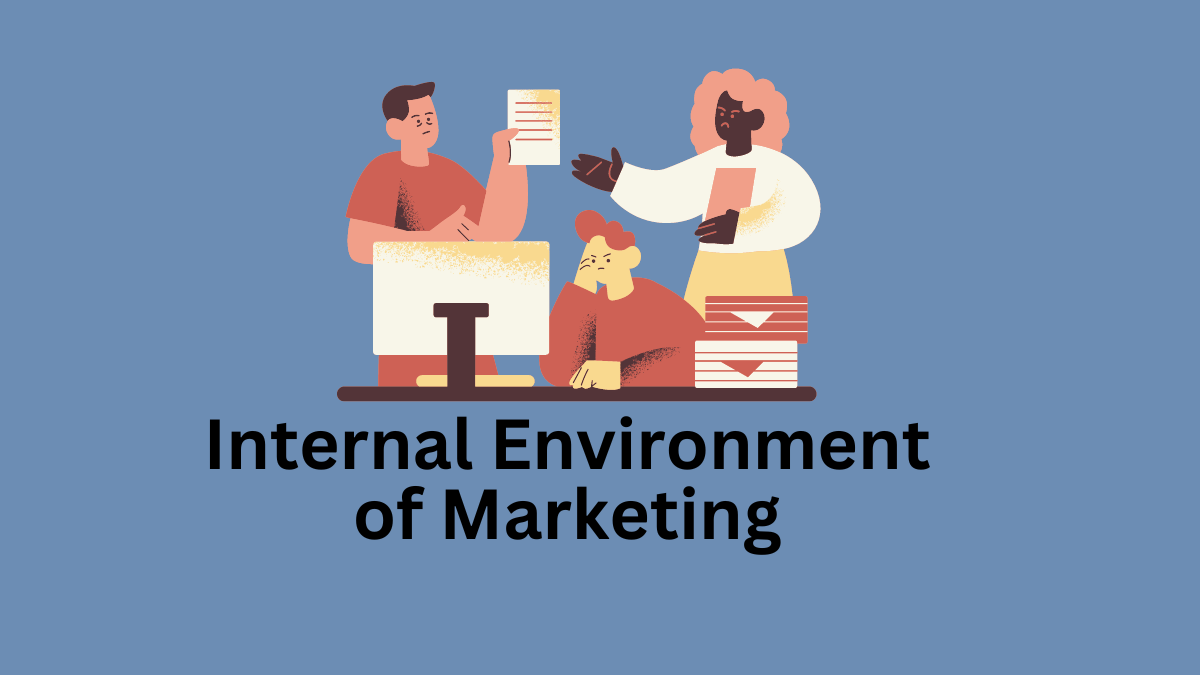What is Internal Environment of Marketing?
The internal environment of marketing encompasses elements within a company’s control, whether tangible or intangible. After identification, these factors are categorized as strengths or weaknesses. Positive impacts are strengths, while obstacles are weaknesses.
Inside the company, numerous criteria should be considered. It’s vital for a business, akin to the external environment. Components like sales, marketing, manufacturing, and human resources departments contribute to this controllable, internal domain. It involves staff, equipment, work processes, culture, and management practices. Members, including owners, employees, shareholders, and directors, influence it.
The internal marketing environment includes factors influencing a company’s marketing operations. These controllable variables range from employees and policies to capital assets and products. This sphere directly impacts marketing strategies. It’s crucial for the company’s overall performance and ability to respond to external influences.
In short, the internal marketing environment refers to elements within a company’s grasp, impacting marketing strategies and overall performance. It involves staff, policies, assets, structure, and products, all controllable by the company.
Elements of Internal Marketing Environment
Let’s explore the key components of the internal marketing environment.
Read Also: Marketing Goals
People (Employees)
The heart of the organization includes both skilled and unskilled workers. They are the ones who contribute their efforts and skills to the company’s goals. Just like a team in a game, every player’s role matters for success.
Time (Minutes)
This represents the speed at which processes in the business take place. Time management is like a race against the clock. The quicker processes are completed, the more efficiently the game is played.
Machinery (Equipment)
The tools and equipment required by the business to get things done. Think of it like a team’s gear and equipment – the right tools help them perform better and reach their targets effectively.
Materials (Supplies)
These are the essential elements needed to carry out operations and produce products. Imagine these as the ingredients in a recipe. Just like you need the right ingredients to make a delicious dish, a business needs the right materials for success.
Money
The financial resource used to invest in machinery, purchase materials, and compensate employees. Money is like the team’s budget. Proper allocation and management ensure that the team can achieve its goals.
Methods (Processes)
Systematic approaches are used to complete tasks and achieve objectives. Think of this as the playbook or strategy a team follows during a game. Following the right methods ensures efficiency and success.
Mindset (Culture)
The collective values, beliefs, and behaviors within the organization. Just like a team’s spirit and companionship, a positive company culture fosters collaboration, innovation, and motivation among employees.
Read Also: Marketing Management – Definition, Objectives
Benefits of Internal Marketing Environment
Here are the benefits of a well-managed internal marketing environment, let’s look at these five benefits:
Team Unity
Just like a harmonious band produces beautiful music, a well-managed internal environment fosters a sense of togetherness among employees. When everyone is on the same page, working towards common goals becomes like playing in sync, creating a powerful and melodious work atmosphere.
Efficiency Boost
Imagine a smooth assembly line where each step seamlessly connects. Similarly, a well-managed internal environment streamlines processes, reducing bottlenecks and hiccups. This efficient flow allows the organization to produce results with precision, like a well-choreographed dance routine.
Innovation Flow
When employees feel valued and empowered, their creative juices flow freely. Just like a garden flourishes when nurtured, a well-managed internal environment cultivates innovation. Ideas bloom, sparking new solutions and improvements that keep the organization ahead of the game.
Employee Satisfaction
A happy team is like a well-tuned instrument, producing beautiful melodies. A well-managed internal environment nurtures job satisfaction, making employees feel appreciated and motivated. This positive vibe results in increased productivity and a happier work atmosphere.
Adaptability
Picture a ship navigating smoothly through changing tides. A well-managed internal environment equips the organization to adapt to shifts in the external world. When employees are engaged and well-informed, they’re more prepared to weather challenges and seize opportunities, just like a ship’s crew adjusting sails to changing winds.
Read Also: The 4 Principles of Holistic Marketing Concept
Strategies To Improve Internal Marketing Environment
Here are 6 strategies you can employ to improve the internal marketing environment,
Open Communication Channels
Think of it as having clear pathways for birds to share messages. Open communication means everyone can speak up and share ideas freely, making the workplace feel like a friendly gathering where everyone’s voice matters.
Skill Building Opportunities
Just like leveling up in a video game, providing training and learning opportunities helps employees grow. When they acquire new skills, it’s like gaining power-ups that enhance their capabilities and boost their confidence.
Recognize and Celebrate
Imagine a star-studded award show celebrating employee achievements. Recognizing and celebrating accomplishments, no matter how small, is like rolling out the red carpet for motivation and enthusiasm, making employees feel like true champions.
Clear Goals and Roles
Picture a well-organized puzzle where each piece fits perfectly. Clear goals and roles are like puzzle pieces, guiding employees to know exactly where they fit and what they’re aiming for, resulting in a complete and beautiful picture.
Promote Work-Life Balance
Visualize a balanced seesaw where work and personal life are in equilibrium. Promoting work-life balance is like ensuring the seesaw stays level, allowing employees to enjoy their job without tipping the scale of their personal life.
Empower Decision-Making
Think of it as handing out magic wands to employees. Empowering them to make decisions is like giving them the power to cast spells and shape their work environment. It sparks ownership and a sense of control, leading to a workplace where everyone feels like a wizard in their domain.
Read Next: 6 Marketing Management Philosophies with Examples
Arti Kushmi holds a BBS (Bachelor in Business Studies) degree and shares her business and marketing knowledge through this website. While not writing she will be reading and enjoying the moment.
